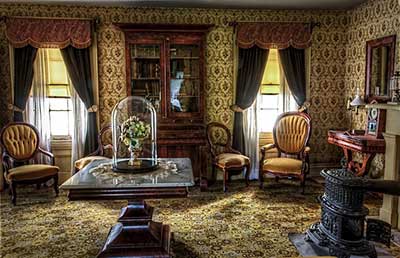Home carpeting really began in Victorian Britain. A collision of economic and social factors made both clothing and home fashion in the period from around 1840 to 1900 very distinctive. If you have a Victorian or a Victoria-style home and are thinking of buying new carpet, here is a quick history of what makes Victorian carpets unique and what you should look for to reflect the style of your house in your carpets.

Before home carpets
Before carpets, floor coverings in most ordinary homes were “oylcloth” over packed dirt—if there were floor coverings at all. Only the very wealthy had carpets. France’s King Louis XIV set up the first European carpet manufacturing trade in the town of Savonnerie by importing Moorish weavers from the Middle East, where carpet making had a long tradition. In 1755, Thomas Whitty of Axminster in Devon County, England, saw one of those carpets and started to manufacture carpet in England using the same skilled immigrants. Made from woven wool, these tufted carpets were created by weaving over a rod, then cutting the loops in a process called Axminster weaving. The process was so labour intensive and took so long that church bells were rung throughout the town when one was finished.
The power loom made carpet affordable
By 1825, looms using punch card “programming” enabled weavers to take up to six varieties of yarn colour at a time and pump out an astonishing 6 to 8 metres of carpet a day! At the dawn of the Victorian era, the power loom had arrived and production doubled. By 1870, one loom could produce 75 metres of carpet per day, so the price dropped dramatically.
The youthful exuberance of Victorian design
To fully understand the carpet boom of the 1860s, you have to understand the buyer. The Industrial Revolution had created a middle class. It was a new, dynamic generation that wanted to leave their parents’ era of endless wars and limited class mobility behind. That meant their homes weren’t decorated in the sparse neoclassic style of the early 1800s. Instead, they filled every space with furniture, lay down brightly coloured rugs and decorated their walls with the new home décor accessory: wallpaper.
There is definitely an Oriental flavour to most Victorian carpet; a look of high status and sophistication. However, it was three architects who inspired the most influential new Victorian carpet designs. A.W.N. Pugin pioneered the arrangement of floral elements into geometric patterns. Owen Jones’ work was very influenced by Eastern designs, not just from the Middle East, but also from Japan. William Morris, the greatest architect of the age, invented the now-familiar trellis design.
In the twentieth century, Victorian design seemed stodgy and conservative, but in the nineteenth century it was a new look, with brightly coloured and free-feeling curves and bold floral patterns against dark backgrounds. Victorian-style carpets and rugs are great for Victorian homes, but who knows? These designs may go mainstream once again.
